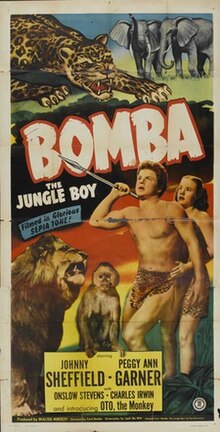
Johnny Sheffield was an American child actor who, between 1939 and 1947, portrayed Boy in the Tarzan film series and, between 1949 and 1955, played Bomba the Jungle Boy.

Tarzan and the Leopard Woman is a 1946 action film based on the Tarzan character created by Edgar Rice Burroughs and portrayed by Johnny Weissmuller. Directed by Kurt Neumann, film sees Tarzan encounter a tribe of leopard-worshippers. It was shot in the Los Angeles County Arboretum and Botanic Garden. Its plot has nothing in common with Burroughs' 1935 novel Tarzan and the Leopard Men.
Walter Mortimer Mirisch was an American film producer. He was the president and executive head of production of The Mirisch Corporation, an independent film production company which he formed in 1957 with his brother, Marvin, and half-brother, Harold. He won the Academy Award for Best Picture as producer of In the Heat of the Night (1967).
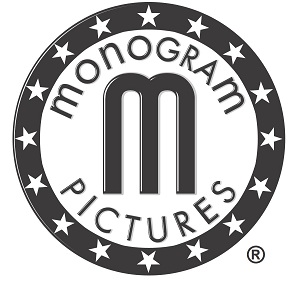
Monogram Pictures Corporation was an American film studio that produced mostly low-budget films between 1931 and 1953, when the firm completed a transition to the name Allied Artists Pictures Corporation. Monogram was among the smaller studios in the golden age of Hollywood, generally referred to collectively as Poverty Row. Lacking the financial resources to deliver the lavish sets, production values, and star power of the larger studios, Monogram sought to attract its audiences with the promise of action and adventure.

Sam Katzman was an American film producer and director. Katzman produced low-budget genre films, including serials, which had disproportionately high returns for the studios and his financial backers.

Stanley Clements was an American actor and comedian, best known for portraying "Stash" in the East Side Kids film series, and group leader Stanislaus "Duke" Coveleskie in The Bowery Boys film series.
The Mirisch Company was an American film production company owned by Walter Mirisch and his brothers, Marvin and Harold Mirisch. The company also had sister firms known at various times as Mirisch Production Company, Mirisch Pictures Inc., Mirisch Films, and The Mirisch Corporation.

Bomba the Jungle Boy is a series of American boys' adventure books produced by the Stratemeyer Syndicate under the pseudonym Roy Rockwood. and published by Cupples and Leon in the first half of the 20th century, in imitation of the successful Tarzan series.
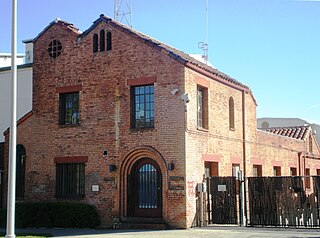
The KCET Studios, located at 4401 Sunset Boulevard in Hollywood, California is the longest continuously-producing studio in Hollywood. Since its establishment in 1912, the studios located at the site have been the home of motion picture producers, including Lubin, Essanay, Willis and Inglis, J.D. Hampton, Charles Ray, Ralph Like, Monogram Pictures, Allied Artists, and ColorVision. Since 1970, it has been the home of public television station KCET, but in April 2011, KCET announced that it had sold the facility to the Church of Scientology.
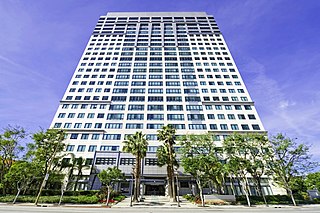
Allied Artists International, Inc. (AAI) is an American multinational mass media and entertainment corporation headquartered in Glendale, California, United States, producing and distributing motion pictures, recorded music, broadcast television, online streaming, video games, and other media products. The company is the successor to Allied Artists Pictures Corporation. In the year 2000, AAI divided its media products into three distinct wholly owned divisions, Allied Artists Film Group (AAFG), Allied Artists Music Group (AAMG) and Allied Artists Music & Video Distribution (AAMVD). Then, around 2020, AAI reorganized itself into four divisions: Allied Artists Music Group, Allied Artists Film Group, Allied Artists Films & Monogram Pictures, & Allied Artists Broadcasting & Allied Artists Music & Video Distribution. Allied Artists Pictures is known for having produced and released such historic motion pictures as Cabaret, starring Joel Grey and Liza Minnelli; Papillon, starring Dustin Hoffman and Steve McQueen; and The Betsy, starring Laurence Olivier, Tommy Lee Jones, Robert Duvall, and Katharine Ross.

William Harris Ruhl was an American character actor of the 1930s, 1940s, and early 1950s.

The Lost Volcano is a 1950 American adventure film. It was the third in the 12-film Bomba, the Jungle Boy series.
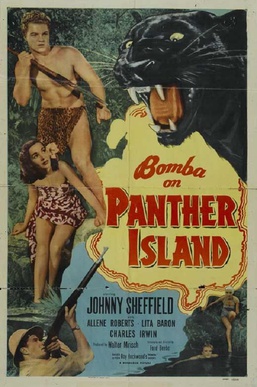
Bomba on Panther Island is a 1949 American adventure film directed by Ford Beebe and starring Johnny Sheffield. It is the second in the 12-film Bomba series following Bomba the Jungle Boy (1949).
Lord of the Jungle is a 1955 American adventure film directed by Ford Beebe and starring Johnny Sheffield. It is the 12th and final film in the Bomba, the Jungle Boy series. It was also Sheffield's final film before his death in 2010.

Killer Leopard is a 1954 American adventure film directed by Ford Beebe and starring Johnny Sheffield and Beverly Garland. It was the eleventh in the twelve-film Bomba, the Jungle Boy series made by Allied Artists.
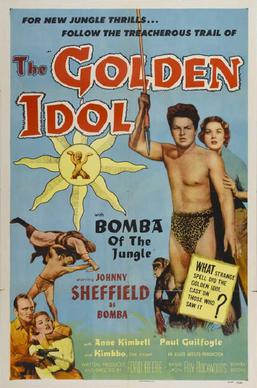
The Golden Idol is a 1954 American adventure film directed by Ford Beebe and starring Johnny Sheffield, Anne Kimbell and Paul Guilfoyle. It was the tenth in the 12-film Bomba, the Jungle Boy series. It was produced and distributed by Allied Artists
Safari Drums is a 1953 American adventure film and starring Johnny Sheffield as Bomba. It was the ninth in the 12-film Bomba, the Jungle Boy series.

Bomba and the Jungle Girl is a 1952 American adventure film directed by Ford Beebe and starring Johnny Sheffield. It is the eighth film in the Bomba, the Jungle Boy film series.

African Treasure is a 1952 American adventure film directed by Ford Beebe and starring Johnny Sheffield. It was the seventh in the 12-film Bomba, the Jungle Boy series.
Jungle Jim is a 1955–56 American TV series based on the Jungle Jim newspaper comic strip. It stars Johnny Weissmuller, who had previously played the character in a series of sixteen theatrically released Jungle Jim feature films, which were produced soon after he retired from the Tarzan film series in 1948 for which he is best remembered.
